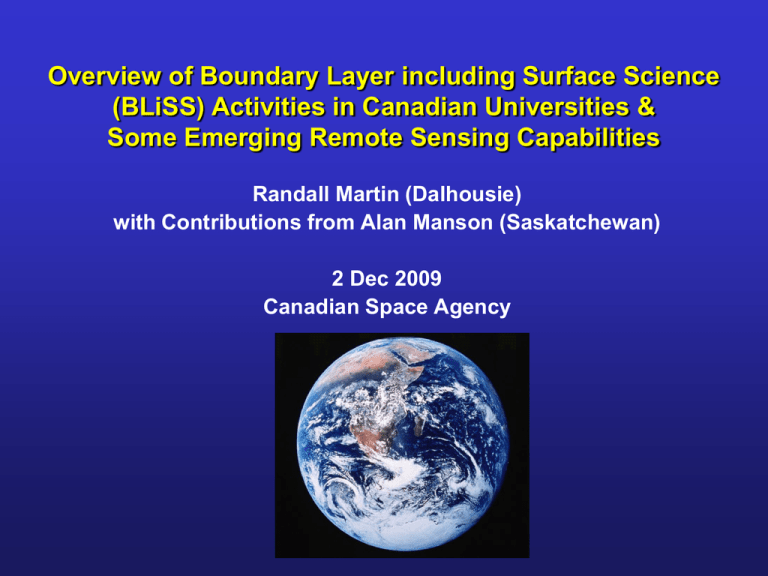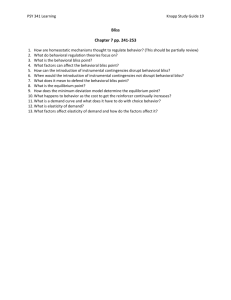Aura NO2 talk - Dalhousie University
advertisement

Overview of Boundary Layer including Surface Science (BLiSS) Activities in Canadian Universities & Some Emerging Remote Sensing Capabilities Randall Martin (Dalhousie) with Contributions from Alan Manson (Saskatchewan) 2 Dec 2009 Canadian Space Agency BLiSS is Central to Canadian Interests in Global Change … but Canadian BLiSS-science often not (yet) engaged with CSA BLiSS broadly interpreted to include the lower troposphere, the Earth's surface, and exchange between the two domains Prominent Issues • Climate change • Air quality Lower troposphere •Nearly half of atmospheric mass •Fully encompasses atmospheric boundary layer •Connects the surface with the atmosphere above Depiction of Various Surface and PBL processes Top of Planetary Boundary Layer (PBL) Some BLiSS Processes cloud formation vertical transport of heat and mass scattering by aerosols and molecules atmospheric instability atmospheric electricity pollution sources precipitation More BLiSS Processes BLiSS Fully within Earth System Science (ESS) BLiSS in Canadian Universities Initial survey reveals ~80 professors, ~300 university staff engaged U British Columbia, Depts of Earth & Ocean Sciences, Geography, Forestry cloud properties; remote sensing; micrometeorology; aerosol transport U Alberta, Dept of Earth and Atmospheric Sciences land use/cover change, sea ice, clouds & storms, micrometeorology U Saskatchewan, Inst Space & Atmospheric Studies, Depts. Geography, Biology atmospheric dynamics/chemistry, remote sensing, hydrology, ecology U Manitoba, Dept of Soil Science micrometeorology, surface fluxes, forest fires Ultrasonic anemometer to measure in-canopy flow Andreas Christen BLiSS in Canadian Universities…continued U Waterloo, Depts Earth & Environ Sciences; Geog. & Environ Management atmospheric modelling, aerosols, satellite retrievals, pollution transport York University, Depts of Earth & Space Science & Engineering, Chemistry, Geography, Biology, Faculty of Environmental Studies boundary layer, climate modelling, air quality, remote sensing U Toronto, Depts of Physics, Chemistry, Forestry, Chemical Engineering aerosols, atmos. chemistry, transport, general circulation, modeling, forests U Ottawa, Dept of Civil Environmental Engineering air quality modelling, data assimilation Jennifer Murphy onboard a research aircraft to measure volatile organic compounds BLiSS in Canadian Universities… continued McGill, Dept of Atmospheric and Oceanic Sciences atmospheric boundary layer, clouds, precipitation, ice-albedo, climate U Québec à Montréal, Department of Earth and Atmosphere Science precipitation, aerosols, snow, remote sensing U Sherbrooke, CARTEL (Centre d’application et de recherche en télédétection) aerosol remote sensing, surface temperature retrieval, soil moisture Dalhousie University, Depts of Physics & Atmospheric Science, Oceanography remote sensing, atmospheric composition, cloud-aerosol, convection, oceans Likely even more … Nitrogen Dioxide from OMI as a Tracer of Combustion Tropospheric NO2 Column (1015 molec cm-2) BLiSS in Government • • • • Environment Canada (MSC, S&T) Natural Resources Canada Department of Fisheries and Oceans Agriculture and Agri-foods Canada Indicator of the state and productivity of vegetation used for information about the strength and location of carbon sinks Shusen Wang Simulated Fraction of Absorbed Photosynthetically Active Radiation Some Emerging BLiSS/ESS Observations CALIPSO Observations of Biomass Burning Aerosol and Marine Stratus 532 nm backscatter Chand et al., Nature Geoscience, 2008 Climatology of Fire Injection Heights Into the Atmosphere Inferred from MISR Satellite Instrument Val Martin et al., ACP, submitted Global Phenology Inferred from MODIS Insight into Timing of Biosphere-Atmosphere Fluxes Zhang et al., JGR, 2006 Satellite Observations of Precipitation-Dynamical Interaction How sensitive to aerosol are cloud cover and radiative forcing? Rob Wood Satellite-based Estimate of Ground-Level Air Quality Aerosol Optical Depth from MODIS & MISR Model Used to Relate Atmospheric Column to Surface PM2.5 Satellite-Derived [μg/m3] Satellite Derived Annual Mean PM2.5 [μg/m3] (2001-2006) Improvement Requires Better Modeling of BLiSS/ESS Processes In-situ In-situ PM2.5 [μg/m3] van Donkelaar et al., EHP, submitted BLiSS Exciting and Active Research Area Initial survey reveals ~80 professors, ~300 university staff engaged Strong need for remote sensing innovation to advance emerging applications in combination with modelling and in-situ measurements Some emerging BLiSS/ESS applications of satellite data • • • • • • • • • insight into the carbon, water, and nitrogen cycles estimate ground-level air quality improve radiative forcing estimates provide top-down constraints on emission sources observe cloud properties and their interactions with aerosol monitor long-range transport of pollution provide information about forest fires and environmental disasters quantify fluxes to/from the biosphere ...





